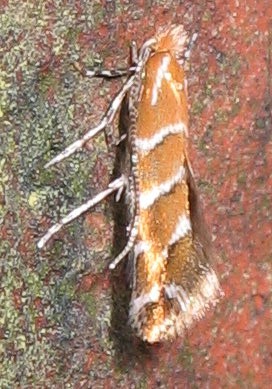
The horse-chestnut leaf miner is a leaf-mining moth of the family Gracillariidae. The horse-chestnut leaf miner was first observed in North Macedonia in 1984, and was described as a new species in 1986. Its larvae are leaf miners on the common horse-chestnut. The horse-chestnut leafminer was first collected and inadvertently pressed in herbarium sheets by the botanist Theodor von Heldreich in central Greece in 1879.

Gracillariidae is an important family of insects in the order Lepidoptera and the principal family of leaf miners that includes several economic, horticultural or recently invasive pest species such as the horse-chestnut leaf miner, Cameraria ohridella.

The leek moth or onion leaf miner is a species of moth of family Acrolepiidae and the genus Acrolepiopsis. The species is native to Europe and Siberia, but is also found in North America, where it is an invasive species. While it was initially recorded in Hawaii, this was actually a misidentification of Acrolepiopsis sapporensis.

The hemlock moth, also known as the defoliating hemlock moth or poison hemlock moth, is a nocturnal moth species of the family Depressariidae. Of Palaearctic origin, it was first found in North America in 1973 when it was accidentally introduced. The moth is now widespread throughout the northern half of the United States, southern Canada, northern Europe, and, more recently, New Zealand and Australia. The larval form grows to around 10 mm, while the adults wingspan is between 17 mm and 19 mm.

Macrosaccus robiniella is a moth of the family Gracillariidae.
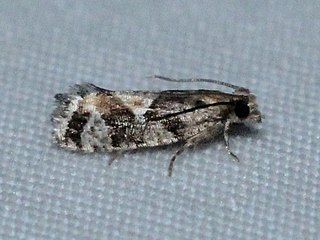
Zeiraphera canadensis, the spruce bud moth, is a moth of the family Tortricidae. It is a small brown moth mainly found in North America, specifically New Brunswick, Quebec, and the north-eastern United States. The adult moth flutters quickly, and stays low among trees during the day and higher above tree cover after sunset. The spruce bud moth relies primarily on the white spruce tree as a host plant. Both male and female spruce bud moths mate multiply, however males have the ability to secrete accessory gland proteins that prevent female re-mating. The moth is univoltine, meaning only one generation hatches per year, and its eggs overwinter from July to May. The species Z. ratzeburgiana is very similar to Z. canadensis and can only be distinguished by the presence of an anal comb in Z. canadensis.

Parornix anglicella is a moth of the family Gracillariidae found in Asia and Europe. It was described in 1850, by the English entomologist Henry Tibbats Stainton, from a specimen from Lewisham, Kent.

Epinotia nanana, the European spruce needleminer, is a moth of the family Tortricidae. It is found from northern and central Europe to Russia and Mongolia.

Herpetogramma licarsisalis, commonly known as the grass webworm or pale sod-webworm, is a species of moth in the family Crambidae.

Phyllonorycter apparella, the aspen leaf blotch miner moth, is a moth of the family Gracillariidae. It is found in most of Europe. It is also present in Turkey and North America.

Cameraria hamadryadella, the solitary oak leafminer, is a moth of the family Gracillariidae. It is widely distributed in temperate North America.

Cameraria aceriella, maple leafblotch miner, is a moth of the family Gracillariidae. It is known from Quebec and Ontario in Canada and Connecticut, Illinois, Kentucky, Pennsylvania, Wisconsin, Maine, Maryland, Michigan, New York, and Vermont in the United States.

Cameraria ulmella is a moth of the family Gracillariidae. It is known from Ontario and Québec in Canada, and Texas, Kentucky, Maine, Maryland, Michigan, New York, Georgia, Illinois and Connecticut in the United States.
Cameraria lobatiella is a moth of the family Gracillariidae. It is known from British Columbia in Canada, and California in the United States.
Cameraria pentekes is a moth of the family Gracillariidae. It is known from British Columbia in Canada, and California and Washington in the United States.

Phyllocnistis hyperpersea is a moth of the family Gracillariidae. It is found from Nansemond and Virginia Beach Counties in Virginia, south along the lowland Atlantic coastal region to the Florida Everglades. It might have a much wider range, since material which might belong to this species has been recorded from Honduras and Mexico.

Phyllocnistis subpersea is a moth of the family Gracillariidae. It is found in the Dade and Monroe Counties of Florida. Mines of what appear to be this species have been found as far north as the Green Swamp in coastal South Carolina.
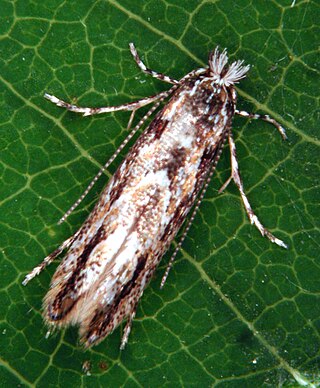
Lithocolletinae is a subfamily of insects in the moth family Gracillariidae. It is distributed worldwide, with most species in temperate regions.
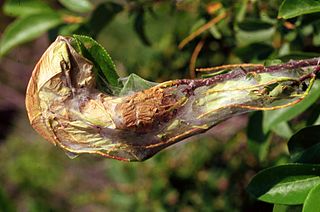
Archips cerasivorana, the ugly-nest caterpillar moth, is a species of moth of the family Tortricidae. The caterpillars of this species are known to create nests by tying the leaves of their host plant together. Caterpillars are seen to follow one another in trails, a behavior prompted by the release of signaling pheromones from their spinnerets.
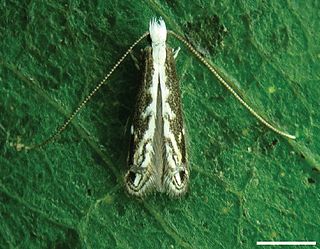
Spinivalva is a genus of moths in the family Gracillariidae. It contains only one species, Spinivalva gaucha, which is found in Brazil.












